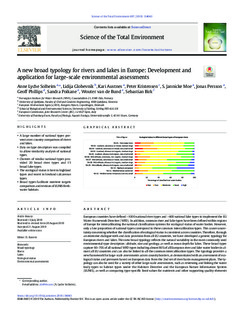| dc.contributor.author | Solheim, Anne Lyche | |
| dc.contributor.author | Globevnik, Lidija | |
| dc.contributor.author | Austnes, Kari | |
| dc.contributor.author | Kristensen, Peter | |
| dc.contributor.author | Moe, S. Jannicke | |
| dc.contributor.author | Persson, Jonas | |
| dc.contributor.author | Phillips, Geoff | |
| dc.contributor.author | Poikane, Sandra | |
| dc.contributor.author | van de Bund, Wouter | |
| dc.contributor.author | Birk, Sebastian | |
| dc.date.accessioned | 2019-11-21T08:22:57Z | |
| dc.date.available | 2019-11-21T08:22:57Z | |
| dc.date.created | 2019-09-26T17:47:31Z | |
| dc.date.issued | 2019 | |
| dc.identifier.citation | Science of the Total Environment. 2019, 697, 1-15. | nb_NO |
| dc.identifier.issn | 0048-9697 | |
| dc.identifier.uri | http://hdl.handle.net/11250/2629642 | |
| dc.description.abstract | European countries have defined >1000 national river types and >400 national lake types to implement the EU Water Framework Directive (WFD). In addition, common river and lake types have been defined within regions of Europe for intercalibrating the national classification systems for ecological status of water bodies. However, only a low proportion of national types correspond to these common intercalibration types. This causes uncertainty concerning whether the classification of ecological status is consistent across countries. Therefore, through an extensive dialogue with and data provision from all EU countries, we have developed a generic typology for European rivers and lakes. This new broad typology reflects the natural variability in the most commonly used environmental type descriptors: altitude, size and geology, as well as mean depth for lakes. These broad types capture 60–70% of all national WFD types including almost 80% of all European river and lake water bodies in almost all EU countries and can also be linked to all the common intercalibration types. The typology provides a new framework for large-scale assessments across country borders, as demonstrated with an assessment of ecological status and pressures based on European data from the 2nd set of river basin management plans. The typology can also be used for a variety of other large-scale assessments, such as reviewing and linking the water body types to habitat types under the Habitats Directive and the European Nature Information System (EUNIS), as well as comparing type-specific limit values for nutrients and other supporting quality elements across countries. Thus, the broad typology can build the basis for all scientific outputs of managerial relevance related to water body types. | nb_NO |
| dc.language.iso | eng | nb_NO |
| dc.publisher | Elsevier | nb_NO |
| dc.rights | Attribution-NonCommercial-NoDerivatives 4.0 Internasjonal | * |
| dc.rights.uri | http://creativecommons.org/licenses/by-nc-nd/4.0/deed.no | * |
| dc.title | A new broad typology for rivers and lakes in Europe: Development and application for large-scale environmental assessments | nb_NO |
| dc.type | Journal article | nb_NO |
| dc.type | Peer reviewed | nb_NO |
| dc.description.version | publishedVersion | nb_NO |
| dc.rights.holder | © 2019 The Authors | nb_NO |
| dc.source.pagenumber | 1-15 | nb_NO |
| dc.source.volume | 697 | nb_NO |
| dc.source.journal | Science of the Total Environment | nb_NO |
| dc.identifier.doi | 10.1016/j.scitotenv.2019.134043 | |
| dc.identifier.cristin | 1729846 | |
| dc.relation.project | EC/FP7/603378 | nb_NO |
| cristin.unitcode | 7464,30,19,0 | |
| cristin.unitcode | 7464,30,23,0 | |
| cristin.unitcode | 7464,20,13,0 | |
| cristin.unitname | Ferskvannsøkologi | |
| cristin.unitname | Nedbørfeltprosesser | |
| cristin.unitname | Økotoksikologi | |
| cristin.ispublished | true | |
| cristin.fulltext | original | |
| cristin.qualitycode | 2 | |

